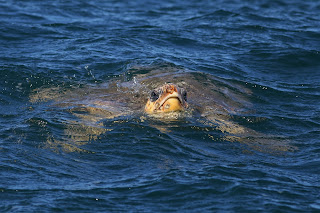There were plenty of birds moving on Sunday morning and we did not have to go much past Diamond Shoals to find some cold water. It got colder as we went, and we saw many Razorbills in the near shore waters (photo by Peter Flood).
A little farther out there were as many or more Razorbills and we examined them with increasing scrutiny. We spotted a few Common Murres, but they were hard to keep up with in the choppy seas and the bright sun glare. We had a little better luck with one Thick-billed Murre. I spotted it flying up the port side, but it wheeled around and landed on the sea in good light, staying put for all to see (photo by Peter Flood).
We had at least one Dovekie buzz by, another was seen briefly on the water. We had a little better luck seeing puffins, but they were scarce compared to last weekend.
A Great Skua was spotted flying up ahead of the boat and it landed on the water. We were able to get a bit closer before it took off, so everyone was able to see it. We also picked up some tubenoses as we traveled offshore. A Great Shearwater came to feed in the slick for a while and we had some Northern Fulmars visit us too (photo by Peter Flood).
South of Diamond Tower we got into some warmer water and a Black-capped Petrel put in a brief appearance. The sea was much bigger in the warm water so we didn’t stay there too long. There weren’t as many birds south of Diamond Sholas but it was good to get back in the lee of the Cape on our way back Sunday afternoon.
By Monday morning the wind was already coming around to the southeast and it made for a confused sea. Nevertheless we made good time getting over to the north side and were soon among the auks. There were also a few gannets around, and less than an hour after crossing the shoals, a Great Skua came to see us (photo by Peter Flood).
I circled the boat back around and it returned to make a victory lap, much closer to the boat the second time. The water had pushed down a bit from Sunday and we had some cloud cover, which helped for scanning the sea all around us. The Razorbills were jumpy and diving a lot, but we eventually found some a couple of Common Murres sitting on the sea (photo by Kate Sutherland).
Tubenoses were scarce, but we managed to see Manx Shearwater and Northern Fulmar again.
Working back southward and closer to the shoals, we found an amazing concentration of Razorbills. A Common Murre molting into breeding plumage made a nice flyby. I had just about given up on seeing a puffin, but Kate spotted one ahead, while another was seen close to the boat (photo by Peter Flood).
South of the shoals the water got warmer as we headed west. Razorbills gave way to Red-throated Loons, and there were also many Bonaparte’s Gulls scattered along the way. I spotted a pair of puffins, but they decided to fly off into the wind. I also saw a single Thick-billed Murre that was headed rapidly to the east. I suspect there are also some alcids down around Cape Lookout where the water cools off again, and perhaps they will make their way by Hatteras in the days to come. As of Wednesday, Feb. 21, there was a steady trickle of Razorbills eastbound at Cape Hatteras, easily seen from shore.
I would like to thank everyone who joined us for this weekend’s trips. We set the bar pretty high last weekend, and it was nice to be able to match that diversity on Sunday. I would also like to thank our spotters, Kate Sutherland and Peter Flood for working the deck both days. Back to back winter trips can be a bit of a workout!
The eBird lists with all species seen can be found here Sunday 2/18 & Monday 2/19 but below is the list of target species for the two trips!
Species List Feb 18, 19
Northern Fulmar 3, 2
Black-capped Petrel 1, 0
Great Shearwater 1, 0
Manx Shearwater 2, 7
Great Skua 1, 1
Dovekie 2, 1
Common Murre 4, 3
Thick-billed Murre 2, 1
Razorbill 2500, 2087
Atlantic Puffin 3, 4
Black-legged Kittiwake 1, 0
Little Gull 1, 0
Humpback Whale 2, 3
Bottlenose Dolphin 45, 60
Harbor Seal 1, 0
Loggerhead Turtle 4, 0
Kemp's Ridley Turtle 1, 0
Thank you to Peter Flood for allowing us to use his photos for this post, here are a few more (all photos unless noted by Peter Flood)!
Great Shearwater from Sunday's trip, this bird fed with the gulls and gannets behind the boat for awhile, diving for fish!
One of the Manx Shearwaters from Sunday with the shore line in the background.
This was our first adult Black-legged Kittiwake for the winter!
The Great Skua from Sunday taking off the water (Kate Sutherland)
Another image of the Great Skua from Monday
One of the young Razorbills on the water from Sunday morning
This was a nice treat to have a Common Murre (L) and Razorbill (R) pose for us right next to the boat!
Northern Gannet diving for some fish behind the boat (Kate Sutherland)Lesser Black-backed Gulls were with us in good numbers on both trips and we had all age classes!

One of the Loggerhead Turtles we had on Sunday
This was a super exciting sighting for us: a Kemp's Ridley Turtle!! Peter was quick and captured this photo of the small turtle as we passed it, you can see how much bigger the beak is than the Loggerhead above and how different the color of the shell is!
















No comments:
Post a Comment